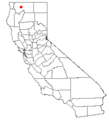Scott Valley facts for kids
Scott Valley is a large, beautiful rural area in western Siskiyou County, California. It's famous for its amazing views of the Marble Mountains, its many cattle and dairy ranches, and its long history as a gold mining region. This history goes all the way back to the exciting days of the California Gold Rush.
Inside Scott Valley, you'll find the towns of Fort Jones, Etna, Greenview, and Callahan, along with several smaller villages.
Contents
A Look Back in Time
Scott Valley has a rich history, shaped by its main river, the Scott River. This river is so special that it's part of the Wild & Scenic Rivers System, which means it's protected for its natural beauty.
Early Inhabitants
When the first Europeans arrived in the 1830s, the valley was home to the Scott Valley branch of the Shasta tribe. These Native Americans lived off the land and rivers for many years.
First European Visitors
In 1836, a group of 19 trappers from the Hudson's Bay Company entered the valley. Among them were Stephen Meek, Thomas McKay, and George Adolphus Duzel. Stephen Meek was a famous trapper who loved the valley. He once said it was one of the best places he had ever seen for trapping beaver and hunting. He even trapped 1,800 beaver from the valley in 1850 alone! Meek later returned to Scott Valley to retire there.
The Gold Rush Arrives
The valley and its river were named after a pioneer named John W. Scott. In 1850, during the California Gold Rush, John Scott discovered gold at Scott Bar, which is downriver from Scott Valley. This discovery brought many gold prospectors, known as Forty-Niners, into the area.
Gold mining continued in Scott Valley for a long time, even into the 1900s. People used special machines called dredges to find gold along the Scott River.
Getting Around Scott Valley
Long ago, an early road passed through Scott Valley. This road was an alternative to the Siskiyou Trail and connected Shasta, California to Yreka, California and then to Oregon. It was used a lot until better stagecoach roads were built in the 1860s, and later, a railroad in the 1880s.
Today, California State Route 3 is the main road serving Scott Valley. It connects places like Hayfork and Weaverville to Yreka. This route also links up with other important roads like California State Route 299, California State Route 36, and the major north-south highway, Interstate 5.
Towns of the Valley
Scott Valley is home to several small towns, each with its own story.
Fort Jones
The town of Fort Jones began in the 1850s as a trading post. It served the many Forty-Niners who came looking for gold. Later, it got its name from a U.S. Army post that was set up nearby. Fort Jones is also where the local weekly newspaper, the Pioneer Press, has been published since 1972.
Etna
The town of Etna was originally called Aetna Mills. It was an important place for early mills that produced flour for the region.
Unique Local Plant
Scott Valley is home to a very special plant called the Scott Valley phacelia (Phacelia greenei). This plant is named after the valley and can't be found anywhere else in the world!
Images for kids



